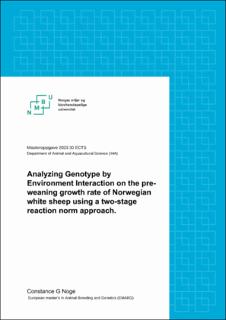| dc.contributor.advisor | Main supervisor: Geier Steinheim Norwegian University of Life Sciences | |
| dc.contributor.advisor | Co-supervisor(s): Gunnar Klemetsdal Norwegian University of Life Sciences | |
| dc.contributor.advisor | | |
| dc.contributor.advisor | Leke Victor Aiyesa Georg-August Universität Göttingen | |
| dc.contributor.author | Noge, Constance G. | |
| dc.date.accessioned | 2023-08-02T16:27:20Z | |
| dc.date.available | 2023-08-02T16:27:20Z | |
| dc.date.issued | 2023 | |
| dc.identifier | no.nmbu:wiseflow:6872687:55139481 | |
| dc.identifier.uri | https://hdl.handle.net/11250/3082400 | |
| dc.description.abstract | This study was aimed at using the two-stage reaction norm approach to analyze genotype by environment interaction in the pre-weaning growth rate of Norwegian white sheep. The NWS sheep data from 2010 to 2021 (12 production years) containing 66 999 sheep data and a pedigree file of 1406 sires and 18051 dams from municipalities Ål and Hol of old Bruskerud county was used in this study. An animal model was used to create an environmental gradient based on the herd year effects, and that environmental variable was then used in an interaction effect in the sire model to determine the presence of genotype by environment interaction. The fixed effects of the animal model (herd year, age of the dam, the month of lambing, and sex) all showed great significance in their predictive ability(p<0.05). The descriptive statistics of the herd year indicated that the average pre-weaning growth rate is 0.344kg/d ± 0.06. It was evident that male lambs grow 0.028kg/d more than female lambs, lambs born in May grow at 0.005kg/d more than those born in April, and lambs born to ewes aged 4 years have the highest weaning growth rate (0.042kg/d) compared to those born to other ewe ages. Two models were run all extending the basic model with additive animal genetic effects and either (1) dam genetic effects or (2) the dam s common environment effects. Extending the model with both maternal genetic effects and the permanent environment of the dam was tried but the model could not converge. The (co) variances and genetic parameters were estimated for the pre-weaning growth rate. The variance component for animal genetic effect was 0.000234 ± 0.018, for dam genetic was 0.000625 ±0.013, and the permanent environment of the dam was 0.00048 ±0.010. The direct animal genetic heritability of pre-weaning growth rate was unexpectedly high (0.388 ± 0.011), for the dam genetic effects heritability was 0.209 ± 0.006, and the dam’s common environment heritability was 0.169 ± 0.005. Offspring yield deviations were predicted using Legendre polynomial coefficients, their interaction with the genotype as a fixed effect showed a p-value of 0.02 each (ie p<0.05) which is significant. The Legendre coefficients were used to provide independent intercepts and linear growth rates along the environmental gradient of each sire. Several sires showed an increase in offspring yield deviations with increasing herd year gradient while other sires showed a decrease in offspring yield deviations across the herd year gradient. These noticeable changes in the ranking of the sires could demonstrate the presence of genotype by environment interaction for pre-weaning growth rate | |
| dc.description.abstract | | |
| dc.language | eng | |
| dc.publisher | Norwegian University of Life Sciences | |
| dc.title | ANALYZING GENOTYPE BY ENVIRONMENT INTERACTION ON THE PRE-WEANING GROWTH RATE OF NORWEGIAN WHITE SHEEP USING A TWO-STAGE REACTION NORM APPROACH | |
| dc.type | Master thesis | |
